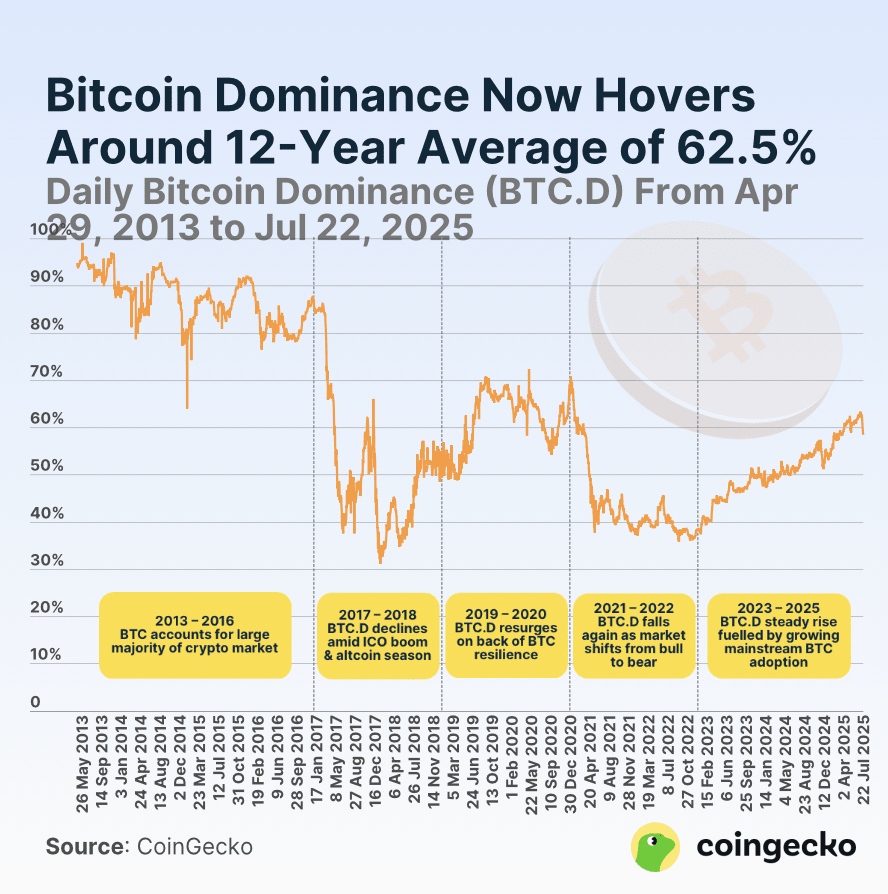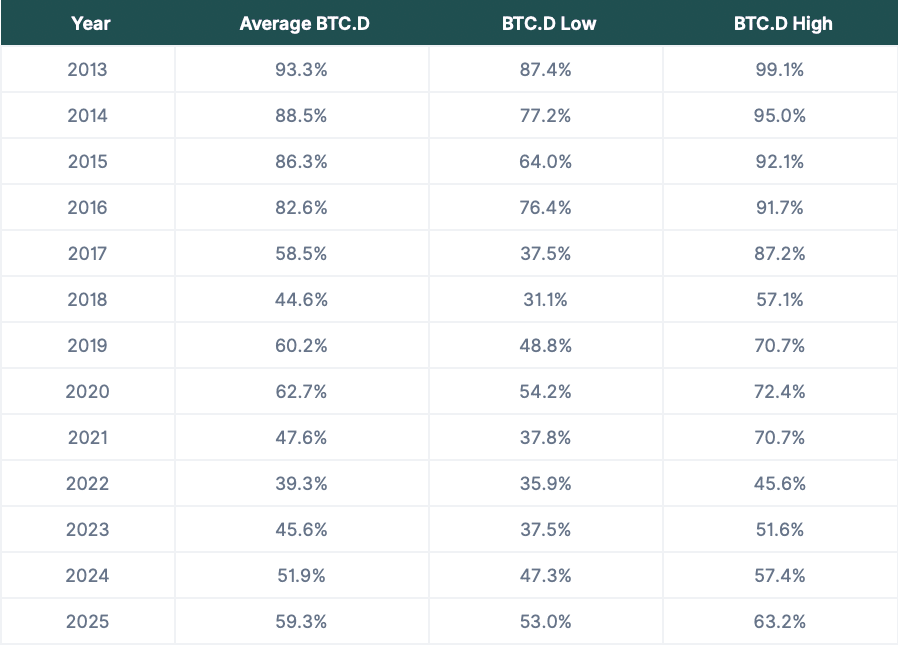This study examines the daily market share of Bitcoin from April 29, 2013, to July 22, 2025, with data sourced from CoinGecko.
How has Bitcoin's market share evolved over the years?
From 2013 to 2025, Bitcoin's market share in the cryptocurrency market has experienced significant fluctuations, oscillating between a historical low of 31.1% and an early high of 99.1%. During this period, Bitcoin's daily market share was above 50.0% for two-thirds of the time. In other words, Bitcoin dominated the cryptocurrency market for a total of 8 years during these 12 years.
Yearly, Bitcoin's daily average market share declined for five consecutive years, dropping from 93.3% in 2013 to 44.6% in 2018. The market share rebounded to 60.2% in 2019, 62.7% in 2020, then fell again to 47.6% in 2021 and 39.3% in 2022.
Since 2023, Bitcoin's market share has once again steadily risen, with an annual average of 45.6% in 2023, 51.9% in 2024, and 59.3% so far in 2025. This means that Bitcoin's market share in 2025 is currently hovering around the 12-year daily average of 62.5%.
 Source: CoinGecko Bitcoin's market share is currently hovering around the 12-year average of 62.5%. Statistical date: April 29, 2013, to July 22, 2025.
Source: CoinGecko Bitcoin's market share is currently hovering around the 12-year average of 62.5%. Statistical date: April 29, 2013, to July 22, 2025.
Key levels of Bitcoin's market share
Since February 2016, Bitcoin's market share has remained well below 90%. This reflects a turning point in the maturation of the cryptocurrency market following the 2017 ICO boom and the first altcoin bull market, during which the number of mainstream altcoins increased, and their market capitalization also grew.
Similarly, after barely recording 70.7% on January 3, 2021, Bitcoin's market share has declined and has remained below 70%. This means that over the past 12 years, Bitcoin's daily average market share has only reached 70% or higher for one-third of the time. Whether Bitcoin's market share will again break the 70.0% threshold remains to be seen.
Notably, on April 7, 2025, Bitcoin's market share rose to 60.5%, the first time it broke the 60% threshold in over four years. The last time Bitcoin's market share exceeded this threshold was on March 15, 2021, when it reached 60.6%. Over the past 12 years, Bitcoin's market share has been below 60.0% for more than half of that time.
Historical development of Bitcoin's market share (2013-2025)
The annual average, minimum, and maximum values of Bitcoin's market share from 2013 to 2025 are as follows.
 Source: CoinGecko
Source: CoinGecko
2013 to 2016: Bitcoin monopolizes the cryptocurrency market
During the period from 2013 to 2016, Bitcoin held a market share of the cryptocurrency market, with a daily average market share ranging between 82.6% and 93.3% each year. Despite some price corrections of Bitcoin and significant regulatory actions taken by the U.S. against the then Bitcoin exchange Mt. Gox, Bitcoin's market share in the cryptocurrency industry peaked at 99.1% on May 29, 2013.
Although Bitcoin holds the vast majority of market share in the cryptocurrency market, during this period, Bitcoin's market share experienced three major fluctuations:
On March 29, 2014, Bitcoin's market share dropped by 10.9 percentage points from the previous day, falling from 89.6% to 78.7%. This occurred after the Mt. Gox collapse and can be attributed to a significant rise in the total market capitalization of cryptocurrencies, followed by a correction.
On January 15, 2015, Bitcoin's market share sharply fell by 16.2 percentage points, from 80.2% to 64.0%. This sudden drop was driven by Bitcoin's price falling from $221 the previous day to $172, marking the bear market bottom following the hacking of the Bitstamp centralized exchange.
On January 16, 2015, Bitcoin's market share rebounded to 80.7%, an increase of 16.7 percentage points from the previous day, as Bitcoin's price also rose back to $211.
2017 to 2018: ICOs and altcoins overshadow Bitcoin
In the following two years, Bitcoin's market share further declined, dropping to a new low during the ICO-driven altcoin bull market of 2017 and the bear market of 2018, well below the thresholds of 80% and 70%. On May 16, 2017, Bitcoin fell below 50% for the first time, reaching 48.5%. Notably, on January 16, 2018, Bitcoin's market share hit a historic low of 31.1%, with the price plummeting from $14,412 to $11,724.
Over the past 12 years, Bitcoin's market share fluctuated the most in 2017, starting at 87.2% and then more than halving to 37.6% by June 19. In the second half of the year, Bitcoin's market share briefly rose, only to drop to an annual low of 37.5%, before rebounding to 66% on December 7 and closing the year at 38.9%.
On the other hand, Bitcoin's market share showed an overall upward trend in 2018, growing from 37.4% at the beginning of the year to 52% at the end.
2019 to 2020: Bitcoin regains dominance at the time of the third halving
In 2019 and 2020, Bitcoin reclaimed its dominance in the cryptocurrency market, maintaining a share between 48.8% and 72.5%. This period of Bitcoin re-establishing dominance resulted from various factors, mainly expectations surrounding the third Bitcoin halving in May 2020, as well as investors returning to quality assets after the ICO boom, early institutional interest in Bitcoin as 'digital gold', and Bitcoin's role as an entry point during the 'DeFi summer' of 2020.
2021 to 2022: Altcoins reassert their influence
During the bull market in 2021 and the crash triggered by the pandemic in 2022, Bitcoin's market share continuously declined by 30.9 percentage points, from 69.5% to 38.6%. In these two years, as altcoins gradually established themselves and began to exert greater influence in the cryptocurrency market, Bitcoin's market share kept decreasing.
During this period, there were 8 out of every 10 days when Bitcoin's market share was below 50%. In other words, out of 730 days, Bitcoin's market share was below 50.0% on 624 days.
Specifically, in 2021, despite Bitcoin's price rising from $29,022 to an all-time high and closing the year at $47,192, an increase of 62.6%, Bitcoin's market share still fell from 69.5% at the beginning of the year to 38.2% at the end. In contrast, during the same period, the total market capitalization of the entire cryptocurrency market outperformed Bitcoin, soaring from $776 billion to $2.3 trillion, an increase of 200.6%.
In 2022, Bitcoin's market share started at 37.9% and ended at 38.6%, as the price of Bitcoin fell by 64.2%, consistent with the overall cryptocurrency market's decline of 64.1%. In other words, Bitcoin was directly impacted by the collapses of Terra-Luna and FTX, as investors turned to fiat currency to mitigate risks.
2023 to 2025: Bitcoin goes mainstream
In the past three years, Bitcoin's market share has steadily risen from 38.4% at the beginning of 2023 to 58.5% so far in 2025. The rebound in Bitcoin's market share reflects a structural shift in the cryptocurrency market, thanks to the approval of the U.S. spot Bitcoin ETF in January 2024 and the increasingly clear regulatory environment following the FTX collapse, which has led to mainstream recognition and institutional adoption of Bitcoin.
Notably, Bitcoin's market share has become increasingly stable, with smaller fluctuations ranging from -1.2 percentage points to +1.6 percentage points. In contrast, during the period from 2013 to 2016, Bitcoin's market share fluctuated between -16.2 percentage points and +16.7 percentage points; while from 2017 to 2022, the range was -8.8 percentage points to +7.0 percentage points.
This article is reprinted with permission from: (PANews)
Original title: (Bitcoin Dominance on the Rise for 3rd Consecutive Year)
Original author: Yuqian Lim, CoinGecko
Translation: Felix, PANews
‘Going Mainstream! A Chart of Bitcoin's Market Share in 5 Stages, Understanding the 12-Year Evolution of the Cryptocurrency Market’ was first published in ‘Crypto City’


